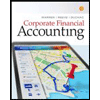
Concept explainers
(1)
Pension expense: Pension expense is an expense to the employer paid as compensation after the completion of services performed by the employees.
Pension expense includes the following components:
- Service cost
- Interest cost
- Expected return on plan assets
- Amortization of prior service cost
- Amortization of net loss or net gain
Debit and credit rules:
- Debit an increase in asset account, increase in expense account, decrease in liability account, and decrease in
stockholders’ equity accounts. - Credit decrease in asset account, increase in revenue account, increase in liability account, and increase in stockholders’ equity accounts.
To journalize: H’s pension expense, if service cost is $10,000,000, interest cost is $6,000,000, expected return on assets is $4,000,000, and amortization of net loss is $2,000,000.
(2)
To journalize: H’s pension expense, if service cost is $10,000,000, interest cost is $6,000,000, expected return on assets is $4,000,000, and amortization of net gain is $2,000,000
(3)
To journalize: H’s pension expense, if service cost is $10,000,000, interest cost is $6,000,000, expected return on assets is $4,000,000, and amortization of net gain is $2,000,000.
Trending nowThis is a popular solution!

Chapter 17 Solutions
INTERMEDIATE ACCOUNTING
- Accounts Payable A chain of appliance stores, APP Corporation, purchases inventory with a net price of $400,000 each day. The company purchases the inventory under the credit terms of 1/15, net 35. APP always takes the discount but takes the full 15 days to pay its bills. What is the average accounts payable for APP?arrow_forwardPlease explain the solution to this financial accounting problem with accurate principles.arrow_forwardCan you help me solve this general accounting question using valid accounting techniques?arrow_forward
- I am trying to find the accurate solution to this general accounting problem with the correct explanation.arrow_forwardPlease provide the correct answer to this general accounting problem using accurate calculations.arrow_forwardPlease explain the solution to this general accounting problem using the correct accounting principles.arrow_forward
- Cost of Trade Credit A large retailer obtains merchandise under the credit terms of 3/20, net 35, but routinely takes 65 days to pay its bills. (Because the retailer is an important customer, suppliers allow the firm to stretch its credit terms.) What is the retailer's effective cost of trade credit? Assume a 365-day year. Do not round intermediate calculations. Round your answer to two decimal places. 25.10 is incorrect.arrow_forwardCan you explain the correct approach to solve this general accounting question?arrow_forwardPlease provide the correct answer to this general accounting problem using valid calculations.arrow_forward
 Intermediate Accounting: Reporting And AnalysisAccountingISBN:9781337788281Author:James M. Wahlen, Jefferson P. Jones, Donald PagachPublisher:Cengage Learning
Intermediate Accounting: Reporting And AnalysisAccountingISBN:9781337788281Author:James M. Wahlen, Jefferson P. Jones, Donald PagachPublisher:Cengage Learning Corporate Financial AccountingAccountingISBN:9781305653535Author:Carl Warren, James M. Reeve, Jonathan DuchacPublisher:Cengage Learning
Corporate Financial AccountingAccountingISBN:9781305653535Author:Carl Warren, James M. Reeve, Jonathan DuchacPublisher:Cengage Learning

